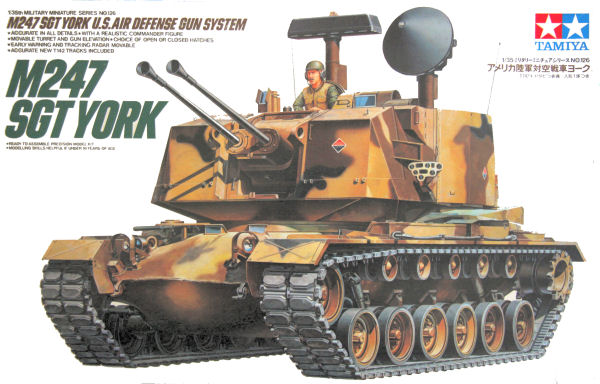
Tamiya 1/35 M247 Sgt. York Kit First Look
By Cookie Sewell
Images by Michael Benolkin
| Date of Review | March 2006 | Manufacturer | Tamiya |
|---|---|---|---|
| Subject | M247 Sgt. York | Scale | 1/35 |
| Kit Number | 3626A | Primary Media | 270 parts (250 in light earth color styrene, 18 in black vinyl; 2 in silver-grey vinyl) |
| Pros | Comes with late model T142 replaceable pad tracks; only model of a SGT York in this scale in styrene | Cons | Maintains all of the problems of the M48A3 kit; based on a wooden mockup and not the production version of SGT York |
| Skill Level | Basic | MSRP (USD) | Out of Production |
First Look
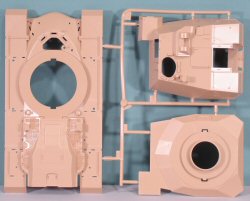 |
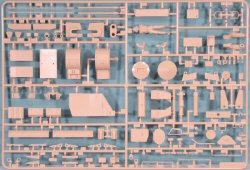 |
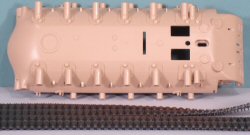 |
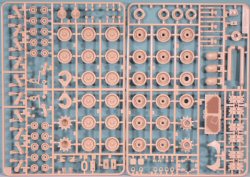 |
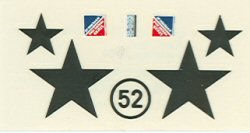 |
There are some ideas which are good, but do not pan out as well as one would hope. Self-propelled antiaircraft weapons are one such class of ideas. The idea dates back to WWI, when both sides began mounting light (relatively speaking) howitzers and machine guns on trucks to provide mobile platforms to deal with balloons and aircraft. This continued in WWII, which saw multiple machine guns and cannon mounted on tracked chassis to provide direct support antiaircraft fire.
Postwar there was a lull in development, but by the late 1960s weapons such as the M42 "Duster" twin 40mm, ZSU-23-4 "Shilka" quad 23mm, Gepard twin 35mm, and various French and other weapons with multiple 30-40mm guns were prevalent. When the M42 began to show signs that it was nearing the end of its usefulness, no longer able to provide fire quickly enough to respond to threats like low-level Soviet jet fighter-bombers, a new weapons system was sought for US heavy divisions.
The new prospective weapon – DIVAD for Division Air Defense, wound up as a competition between General Dynamics and Ford Aerospace. The winner, the Ford version, was somewhat better received than the GD model, even though that offering had suffered fewer problems in testing. Ford received a contract in May 1981 for 618 systems after the 1980 shoot-off, but began to suffer more and more problems. The most famous of these was when the radar on one gun evaluated a tree as a threat target and engaged it. But by 1984, with only 12 prototypes built and fielded and another 41 in the pipeline, the project was then estimated to cost $1.8 billion to fix over the $6.5 billion budgeted for the weapons. Many commanders also did not see the older M48A5 chassis as being able to keep up with the new M1/M2/M3 combat team then entering full service. Thus, in August 1985 Secretary of Defense Weinberger lived up to his nickname of "Cap the Knife" and cancelled the system.
The handful of the 53 production and preproduction vehicles which were produced went to automotive and other test commands, with at least two being used on USAF and Navy bombing ranges as trackers. One vehicle at least survives intact today at APG in the collection of the Ordnance Museum.
To complement their M1 and M2/M3 kits, Tamiya rushed out a kit of the M247 SGT York in 1983, based heavily on their M48A3 Patton in Vietnam kit. Unfortunately, they did not use a production or prototype vehicle, but a wooden mockup that had been displayed to the press and was missing a great deal of kit found on the actual production model of SGT York. The result was a real mishmash of parts which, when photos of the production variants appeared in early 1984, showed the kit to be off the mark.
To describe this kit, Tamiya took the "A" and "B" sprues from their M48A3 and added or replaced another 112 parts in the kit. The lower hull is identical to the M48, to include being a scale 4" too tall due to mensuration of a completely unladen tank in a motor pool. Anyone wishing to model this chassis has to first trim off the shock absorbers and reset the suspension arms to reflect the lower ride height. (If you don't, the model looks more like a toy tank than a miniature.)
The model is again based on the M48 chassis, and in one word – motorization – the rest of the lower hull's problems become obvious. However, Tamiya is good at one thing, and that is that they usually catch changes in tracks: this model comes with the late production M48/M60 T142 tracks with the octagonal replaceable pads. The tracks alone fix most major problems in older Tamiya M60 kits, as well as provide an option for ESCI kits for fans of one-piece vinyl tracks.
The upper hull has also been changed to better reflect the A5 mods rather than the A3, and if you want to make a model of an A5 this is a good choice for a base chassis.
What the hull in the kit does NOT do is replicate the production SGT York. Ford had a very hard time getting thermal suppression on the engine deck and rear of the tank once the generator and other parts had been installed, and as a result, there were major modifications made to the rear of the hull, A much taller armored casemate was added, with four thin horizontal vents the top at the rear, and other changes were made as it had to also provide for all around traverse of the turret with its bulky target tracking radar on the left side. Tamiya simply provided the dummy plywood shell on the mockup (part C-74) with an odd box tacked to the top of it (part C-67.)
The turret reflects the partial design solutions displayed by the mockup, such as having the ammunition bay doors latched at the bottom front (on the box art, not the kit.) The real ones hinged at the rear with large latches at the front next to the mantlet. The smoke projectors are also shown as on the mockup, as the actual vehicle had them placed about two feet higher on the ammo bay doors. Parts C-70 and C-71 are also bogus hinges as shown on the mockup. Also missing was a self-defense M60 machine gun mount for the commander, located right in front of his hatch and between his viewers.
The list can go on and on, but the bottom line was that they rushed this kit out too quickly, and it shows.
Overall, it is the only game in town if you want to capture one of the few major American weapons decision failures in the last 30 years. But be prepared to do a lot of research and rebuilding of the engine deck and hull rear, as well as a good deal of correction to the turret details.







